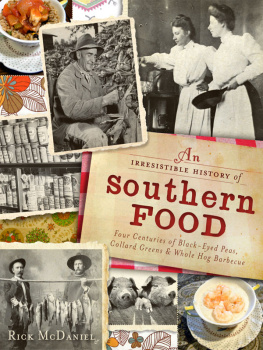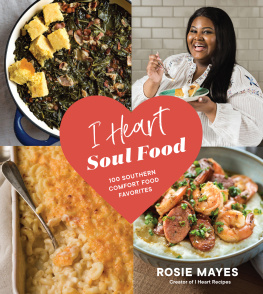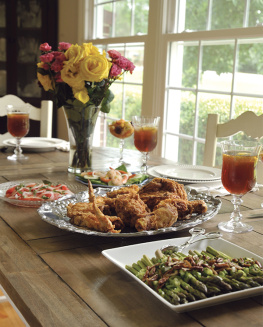

Published by The History Press
Charleston, SC 29403
www.historypress.net
Copyright 2011 by Rick McDaniel
All rights reserved
Front cover (clockwise from top), archival images courtesy of: Lewis P. Watson Photographic Collection; Vanishing Georgia Collection, Georgia State Archives; Lewis P. Watson Photographic Collection; Georgia State Archives and North Carolina State Archives.
All food photography by Polly McDaniel unless otherwise credited.
Cover design by Natasha Momberger.
Hardcover edition first published 2011
Paperback edition first published 2012
e-book edition 2013
Manufactured in the United States
ISBN 978.1.62584.146.9
Library of Congress Cataloging-in-Publication Data
McDaniel, Rick.
An irresistible history of Southern food : four centuries of black eyed peas, collard greens, and whole hog barbecue / Rick McDaniel ; original photographs by Polly McDaniel, Robert Lahser, and Royce W. Smith.
p. cm.
Includes bibliographical references.
print edition ISBN 978-1-60949-808-5
1. Cooking, American--Southern style. 2. Cooking--Southern States--History. 3. Cookbooks. I. Title.
TX715.2.S68M3325 2011
741.5975--dc22
2011008301
Notice: The information in this book is true and complete to the best of our knowledge. It is offered without guarantee on the part of the author or The History Press. The author and The History Press disclaim all liability in connection with the use of this book.
All rights reserved. No part of this book may be reproduced or transmitted in any form whatsoever without prior written permission from the publisher except in the case of brief quotations embodied in critical articles and reviews.
To Georgia Pearl Long Styers, Margaret Styers Tate,
Bess Smith Chapman, Ruth Canipe Hill, Lorene Hovis Hill
and Josie Hill McDanielthree generations of small women
who were giants in the kitchen.
Contents
Acknowledgements
One of the biggest lies anyone can ever tell you is Im writing a book. Unless you are a true genius (and there are entirely too few of those running around these days), writing a book involves every friend and loved one you have, to one degree or another.
Id like to thank my wife, Polly, and my son, Morgan, who put up with this obsession I had about putting my passion for Southern food onto the printed page. In addition to taking almost all the original photographs for the book, Polly provided advice, encouragement, editing and an uncanny knack for telling me when I was rambling on a tad too much about the virtues of lard. Morgan dutifully tramped over every plantation in the upper South, listening to me talk with fellow food historians, which he no doubt found far more interesting than video games. My sister, Cathy, and her husband, Darrell, gave me many of the nineteenth-century cookbooks in my reference collection, and the rest of my family provided opinions, constructive criticism, Scotch and cheerleading as needed.
The staff of the Charleston Library Society was immensely helpful during numerous trips down there to examine their rare cookbook collection.
Robert Lahser and Royce W. Smith provided more than thirty years of friendship and quite a few beautiful photos of the recipes.
The China DollsCarolyn Dorner, Rita Larkin, Nicole Orlovitz, Virginia Himmelheber and Carol Rifkinloaned me most of the beautiful china and table linens you see in the original photographs, for which I am most grateful.
There are many historical photographs throughout this book, many seen in print for the first time. Many thanks are due to Steve Engerrand and Gail DeLoach at the Georgia State Archives, Karen Allen at the Olivia Raney Local History Library in Raleigh, Beth Bilderback at the Caroliniana Library at the University of South Carolina, Kim Cumber and Boyd Cathey at the North Carolina State Archives and Keith Longiotti at the University of North Carolina Libraries.
For more than four decades now, John Masters has always been there to listen and give sage advice, even when I didnt ask for it or even know I needed it. He started my website and is the one who does all the grunt work while I sit back and get written up in the New York Times. Thanks, man. I owe you much.
John T. Edge, one of the best food writers of our generation and director of the Southern Foodways Alliance, has always given good advice and genuinely understands why a man needs his favorite barbecue joint on speed dial.
Damon Lee Fowler, author, food historian and one of the nicest people I have ever met, provided inspiration, knowledge, friendship and encouragement, for which I am very grateful.
Last, but certainly not least, a special thanks to everyone at The History Press, especially my editors, Jessica Berzon and Hilary McCullough. Jessica talked me out of several panic attacks during the craziness of turning a Word document into a book. Hilary, one of the best copy editors I have ever worked with, was amazing at finding glitches and gaffes my bleary eyes missed. Many thanks to you both, and to everyone else who had a hand at getting these words onto the printed page.
Introduction
More than twenty years have passed since the exchange I had with a waitress one winter morning in Clifton, New Jersey.
It was the first time in my life I had traveled North of the fabled Mason-Dixon line, and when asked what I wanted for breakfast, I naturally asked for country ham and grits with my eggs. Whats that? came the reply, along with a genuinely perplexed look, and all of a sudden I realized that I was a long, long way from home.
Southern hospitality has always been synonymous with gracious entertaining and sumptuous feasts. This book looks at the foods Southerners have made their own during the four centuries since the first English settlers arrived in Virginia, where those foods came from and why those particular foods endured.
What we consider Southern cooking was not a revolution that occurred at any one time or place. It was an evolution of foods and cooking techniques from the many and varied ethnic groups who settled the region; some who came to start a new life, some who were stolen from the life they knew and forced into bondage and some whose lives changed forever when they saw the great white sails on the ships bringing strangers to their land.
Over the years, tens of thousands of books have been written about Southern cooking. The overwhelming majority of these books are reminiscences and recipes from someone who lived in a particular place in the South at a particular time. Very few books have been written about the food itself and where it came from; the aim of this book is to bridge the gap between history book and cookbook.
Food and history may seem like strange bedfellows at first, but the two are inescapably intertwined. From the moment of birth until death writes our final chapter, we take food for the nourishment of our bodies and the comfort of our souls. No matter who we are or what time period we may live in, the food we eat is largely determined by our social class and ethnic background, whether we realize it or not.
We grow up eating many of the same foods our parents ate, although each succeeding generation manages (for the most part) to eat better than the last. And no matter how long we might live or how far we may travel, the food of our youth always has an allure unmatched by any other.
Next page










